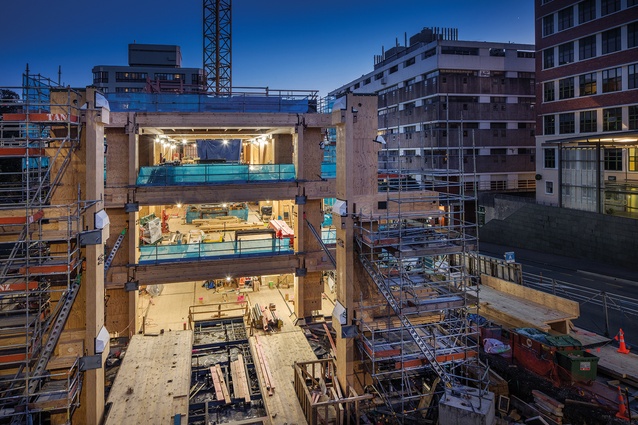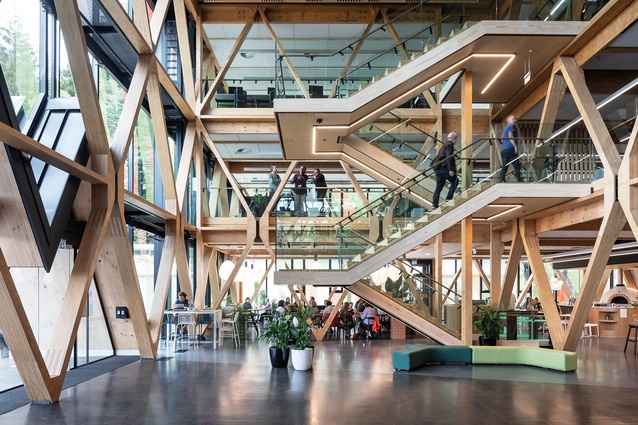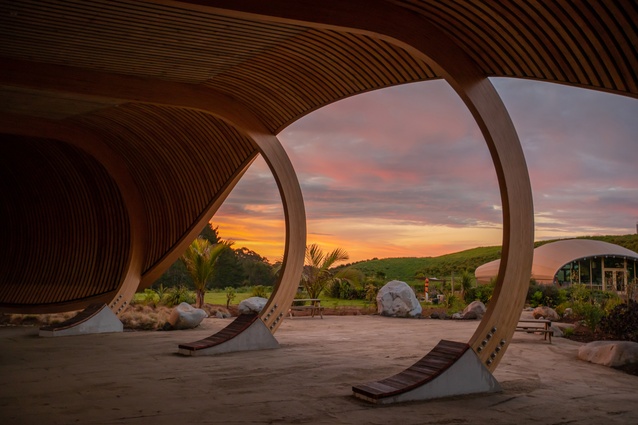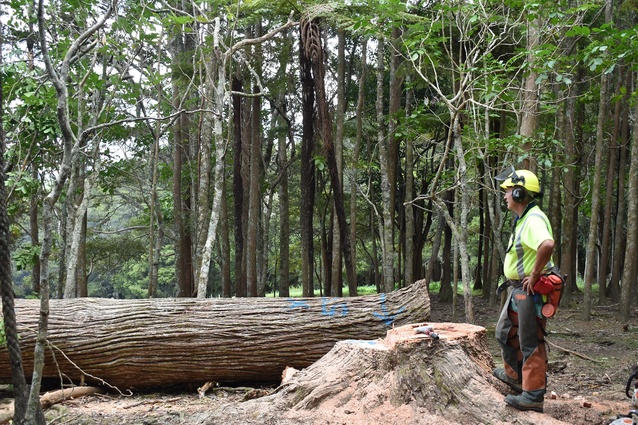Building Change: The mass timber revolution and its hidden impact on our carbon footprint
New Zealand has a unique opportunity to lead the charge in sustainable construction practices, particularly in the realm of mass timber. Carbon measurement expert and director of The Lever Room, Rebecca Mills, is working to help industry practitioners understand this burgeoning sustainable construction method.
Globally an increasing number of companies are embracing mass engineered timber (MET) as a way to cut their carbon footprints and promote their sustainability credentials, including Walmart Inc., Microsoft Corp. and Alphabet Inc.’s Google. YouTube in late 2023 opened two new buildings at its San Bruno, California, headquarters that have timber structures, which the company says halve the emissions of a concrete-and-steel design.

More locally in Tauranga, Warren and Mahoney’s 90 Devonport, an eight-storey mass timber office building, shows the benefits of mass timber construction. It is reported to achieve a 60% reduction in upfront emissions compared to conventional concrete and steel models.
In Wellington, Tennent Brown Architects have designed The Living Pā for Te Herenga Waka Marae, a three-storey, 3000m² mass timber building that is hoped to set a precedent for the future in meeting the Living Building Challenge.
Other celebrated precedents for mass-timber building in this country include the multi-award-wining Scion Innovation Hub in Rotorua, considered an international timber architecture icon.
Lastly, the WAF prize-winning Fisher & Paykel Global Headquarters by RTA Studio, is among the country’s future buildings heralding in a new carbon-resilient building typology that utilises mass timber construction.
Tapping into global trends
While architects in New Zealand are embracing the global trend of mass timber, current practice often involves sourcing wood offshore which, although necessary, presents an opportunity for a more sustainable and economically advantageous long-term outcome by fostering a robust mass timber industry within our own country.
MET, used in large-scale construction projects, is gaining traction globally. Overseas trends include automated design, government and organisational RFPs specifying timber or Zero Carbon solutions, recognition of reduced embodied carbon, changes in international codes allowing for taller wooden structures, and significant investments by industry players.1
“While use of MET has proven benefits, until there is industry that supports its use, the supply of mass timber will continue to be supplemented via imports, hiking up overall carbon emissions.”
International design, engineering and advisory Aurecon, a Principal Partner in the AUD 16.5M ‘Future Timber Hub’ administered by The University of Queensland for the advancement of timber in Australia, agree on the need for a primary MET industry to provide an available supply:
“Across Asia, New Zealand and Australia, supply chain options are mixed in the local context. For example, there is currently only one CLT manufacturer of scale in Australia (Xlam). In New Zealand, there is a larger selection of suppliers, including Techlam, Nelson Pine, Red Stag, and TimberLab, and their scale is ramping up.”
New players entering the market (e.g. Timberlink), may impact the level of competition enough to improve supply chain issues and drive down costs, however Aurecon warn: “There is a risk of encouraging too much demand for MET which could adversely impact supply and cost of timber frames used in housing that could further exacerbate the housing supply and affordability crisis.”
While use of MET has proven benefits, until there is industry that supports its use, the supply of mass timber will continue to be supplemented via imports, hiking up overall carbon emissions.

Environmental impact and carbon reduction
Converting half of the steel and concrete used in new building construction in New Zealand to timber could substantially reduce national embodied carbon emissions.
Calculations by PTL consultants suggest a reduction of one million tonnes of CO2-e annually, equivalent to 2.5% of the country’s total non-agricultural CO2-e emissions. This transition would require an 8% increase in annual log consumption, with 6% of current log exports redirected to local processing facilities.
“Although details vary, the most frequent approaches share the common characteristic that carbon gains from the regrowth of trees from previous human land management — and sometimes further growth of unharvested trees — cancel out carbon losses due to new harvests.”
The greenhouse gas (GHG) effects of forest harvests are accounted for in different contexts: Lifecycle calculations of wood products; national reporting of GHGs by governments; and scientific analyses assessing emissions from land-use change.
Although details vary, the most frequent approaches share the common characteristic that carbon gains from the regrowth of trees from previous human land management — and sometimes further growth of unharvested trees — cancel out carbon losses due to new harvests.
Designing an impactful industry model
The benefits of using timber in new builds is clear, however, to maximise them we will need to ensure we are intentional with potential impacts of harvests and already ‘squeezed’ land resources.
The types of trees and methods of harvest will be important to maximise the amount of harvested tree that makes it into the timber replacing concrete and steel.
“The benefits of using timber in new builds is clear, however, to maximise them we will need to ensure we are intentional with potential impacts of harvests and already ‘squeezed’ land resources.”
Overseas, we are seeing research that shows a large proportion of a tree that gets harvested for mass timber ends up as a waste or a byproduct that has the potential to release much of the carbon it once stored.
On balance, it’s a good rule of thumb that a well-sourced mass timber building will be lower carbon than the equivalent made of concrete or steel, but it is worth considering the hotly disputed, macro-scale land-use concerns.
Inherent sustainability of mass timber
Mass timber exhibits inherent fire-resistant qualities due to its unique assembly. The charring of its outer layer forms an insulating barrier that protects the inner core, showcasing its durability and longevity. Ongoing innovation, such as advancements in fabrication techniques, further increases the sustainability and financial viability of mass timber.
Challenges and solutions
While mass timber proves to be cheaper per square foot, there is a learning curve associated with its proper use and care. Innovations in fabrication techniques and quality control measures are essential to ensure the material’s long-term success.
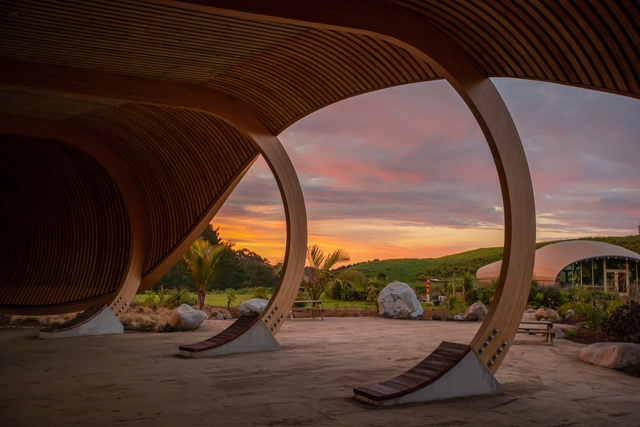
Timber Unlimited and Government support
Timber Unlimited, formerly the Timber Design Centre, promotes timber design and innovation in New Zealand. With funding from the Government’s Forestry and Wood Processing Industry Transformation Plan (ITP), Timber Unlimited provides research, technical expertise, and tools to encourage the use of wood in construction projects, aiming to address the alarming 66% increase in carbon emissions from the construction sector over the last decade.
New Zealand native timber
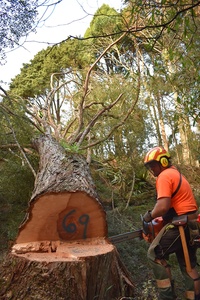
The opportunity to use native timbers and develop a self-sufficient industry using our local resource is an exciting one. Taking a long-term view offers many benefits commercially, environmentally, and culturally.
The Tōtara Industry Pilot represents a two-year study exploring the opportunities of continuous canopy management for regenerating stands of tōtara. This initiative aligns with the values of kaitiakitanga, blending conservation, timber production, environmental enrichment, and cultural preservation.
Beyond tōtara, the carbon measurement and removals organisation The Lever Room — in which I am Director — is supporting organisations to obtain accurate carbon sequestration values for those growing and using native timbers.
Life Cycle Assessments (LCAs)
LCAs are key in measuring operational carbon emissions from the energy and other resources used for operating the building and embodied carbon emissions created from the beginning of the building’s design through its lifetime.
It’s important to note that LCA’s extend beyond carbon considerations; they also encompass other environmental impacts such as water usage, land use, resource depletion, and pollution. However, in the context of environmental sustainability and regulatory frameworks, carbon footprints often take precedence due to their significant contribution to climate change.
“As we get closer to mandatory reporting requirements and eventually caps for the whole-of-life embodied carbon of buildings, the detail will become increasingly important and generic tools may not be sufficient to accurately determine the reality of carbon emissions.”
The specificity and usefulness of these LCAs vary, depending on whether a generic tool or bespoke assessment is used. Generic LCAs are mostly international and give general indications of measurement but cannot consider things such as specific local materials, transport and distance, energy sources, climate and construction methods.

As we get closer to mandatory reporting requirements and eventually caps for the whole-of-life embodied carbon of buildings, the detail will become increasingly important and generic tools may not be sufficient to accurately determine the reality of carbon emissions.
New Zealand stands at the cusp of a sustainable revolution in construction. Embracing mass timber not only offers environmental benefits but also supports the local economy, provides biodiversity advantages, and positions the country as a leader in innovative and sustainable architectural practices. It’s time to seize the opportunity and build a future where our buildings actively contribute to carbon removal and a healthier planet.
References:
1. Accessed via: https://www.mpi.govt.nz/dmsdocument/52834-Carbon-footprint-of-New-Zealand-buildings-



